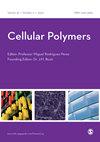生物聚合物增强聚乙酸乙烯酯泡沫的力学和热性能
IF 1.3
4区 医学
Q4 MATERIALS SCIENCE, BIOMATERIALS
引用次数: 1
摘要
采用先进的冷冻干燥技术开发设计了具有良好隔热性能、阻燃性能和力学性能的聚醋酸乙烯酯(PVAc)泡沫材料。用漂白硫酸盐浆、水溶性壳聚糖和硼酸锌的不同组合来增强泡沫。泡沫材料具有良好的抗压和抗弯性能,抗压强度和抗压模量分别为0.01 MPa ~ 0.08 MPa和0.05 MPa ~ 0.29 MPa,抗弯强度和抗弯模量分别为0.12 MPa ~ 5.37 MPa和9.86 MPa ~ 260、85 MPa。使用硼酸锌作为增强剂可以改善热性能,并将600℃时的质量损失降低20.69%。导热系数测试表明,泡沫的导热系数较低,范围为0.037 ~ 0.074 W/mK。硼酸锌(60 g/L)和高分子量水溶性壳聚糖(70 g/L)增强泡沫的极限氧指数(LOI)较高,为28.72%。综上所述,研究结果表明,聚氯乙烯泡沫材料在保温和建筑领域具有良好的可持续发展前景。本文章由计算机程序翻译,如有差异,请以英文原文为准。
Mechanical and thermal properties of polyvinyl acetate foams reinforced with biopolymers
The study developed and designed polyvinyl acetate (PVAc) foams using advanced freeze-drying technology, which exhibited good heat-insulating ability, flame retardancy, and mechanical properties. Different combinations of bleach kraft pulp, water-soluble chitosan, and zinc borate were used to reinforce the foams. The foams exhibited desirable compression and flexural properties, with compression strength and compression modulus ranging from 0.01 MPa to 0.08 MPa and 0.05 MPa to 0.29 MPa, respectively, while flexural strength and flexural modulus ranged from 0.12 MPa to 5.37 MPa and 9.86 MPa to 260,85 MPa, respectively. The use of zinc borate as a reinforcement resulted in improved thermal properties and reduced mass loss at 600°C by 20.69%. Thermal conductivity tests indicated that the foams had low thermal conductivity values ranging from 0.037 W/mK to 0.074 W/mK. The foams with zinc borate (60 g/L) and high molecular weight water-soluble chitosan (70 g/L) reinforcement exhibited high limiting oxygen index (LOI) of 28.72%. Overall, the results suggest that the PVAc foams could serve as a promising sustainable alternative in thermal insulation and construction fields.
求助全文
通过发布文献求助,成功后即可免费获取论文全文。
去求助
来源期刊

Cellular Polymers
工程技术-材料科学:生物材料
CiteScore
3.10
自引率
0.00%
发文量
9
审稿时长
3 months
期刊介绍:
Cellular Polymers is concerned primarily with the science of foamed materials, the technology and state of the art for processing and fabricating, the engineering techniques and principles of the machines used to produce them economically, and their applications in varied and wide ranging uses where they are making an increasingly valuable contribution.
Potential problems for the industry are also covered, including fire performance of materials, CFC-replacement technology, recycling and environmental legislation. Reviews of technical and commercial advances in the manufacturing and application technologies are also included.
Cellular Polymers covers these and other related topics and also pays particular attention to the ways in which the science and technology of cellular polymers is being developed throughout the world.
 求助内容:
求助内容: 应助结果提醒方式:
应助结果提醒方式:


